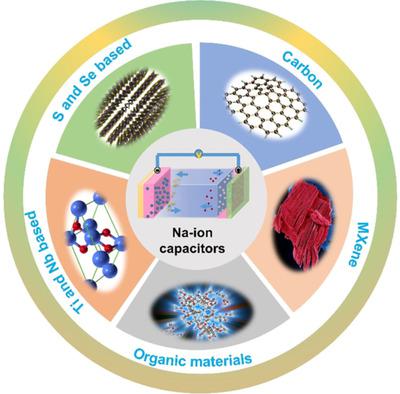当前位置:
X-MOL 学术
›
ChemSusChem
›
论文详情
Our official English website, www.x-mol.net, welcomes your
feedback! (Note: you will need to create a separate account there.)
Sodium-ion capacitors: Materials, Mechanism, and Challenges.
ChemSusChem ( IF 7.5 ) Pub Date : 2020-02-11 , DOI: 10.1002/cssc.201903440 Yadi Zhang 1, 2 , Jiangmin Jiang 1 , Yufeng An 1 , Langyuan Wu 1 , Hui Dou 1 , Jiaoxia Zhang 2, 3 , Yu Zhang 4 , Shide Wu 5 , Mengyao Dong 2, 6 , Xiaogang Zhang 1 , Zhanhu Guo 2
ChemSusChem ( IF 7.5 ) Pub Date : 2020-02-11 , DOI: 10.1002/cssc.201903440 Yadi Zhang 1, 2 , Jiangmin Jiang 1 , Yufeng An 1 , Langyuan Wu 1 , Hui Dou 1 , Jiaoxia Zhang 2, 3 , Yu Zhang 4 , Shide Wu 5 , Mengyao Dong 2, 6 , Xiaogang Zhang 1 , Zhanhu Guo 2
Affiliation

|
Sodium-ion capacitors (SICs), designed to attain high energy density, rapid energy delivery, and long lifespan, have attracted much attention because of their comparable performance to lithium-ion capacitors (LICs), alongside abundant sodium resources. Conventional SIC design is based on battery-like anodes and capacitive cathodes, in which the battery-like anode materials involve various reactions, such as insertion, alloying, and conversion reactions, and the capacitive cathode materials usually depend on activated carbon (AC). However, researchers have attempted to construct SICs based on battery-like cathodes and capacitive anodes or a combination of both in recent years. In this Minireview, charge storage mechanisms and material design strategies for SICs are summarized, with a focus on the battery-like anode materials from both inorganic and organic sources. Additionally, the challenges in the fabrication of SICs and future research directions are discussed.
中文翻译:

钠离子电容器:材料,机理和挑战。
设计用于实现高能量密度,快速能量传输和长寿命的钠离子电容器(SIC),由于其可与锂离子电容器(LIC)媲美的性能以及丰富的钠资源而备受关注。常规的SIC设计基于电池状阳极和电容性阴极,其中电池状阳极材料涉及各种反应,例如插入,合金化和转化反应,而电容性阴极材料通常依赖于活性炭(AC)。但是,近年来,研究人员已尝试构建基于电池状阴极和电容性阳极或两者结合的SIC。在此Minireview中,总结了SIC的电荷存储机制和材料设计策略,重点研究无机和有机来源的电池状负极材料。此外,还讨论了制造SIC的挑战和未来的研究方向。
更新日期:2020-02-11
中文翻译:

钠离子电容器:材料,机理和挑战。
设计用于实现高能量密度,快速能量传输和长寿命的钠离子电容器(SIC),由于其可与锂离子电容器(LIC)媲美的性能以及丰富的钠资源而备受关注。常规的SIC设计基于电池状阳极和电容性阴极,其中电池状阳极材料涉及各种反应,例如插入,合金化和转化反应,而电容性阴极材料通常依赖于活性炭(AC)。但是,近年来,研究人员已尝试构建基于电池状阴极和电容性阳极或两者结合的SIC。在此Minireview中,总结了SIC的电荷存储机制和材料设计策略,重点研究无机和有机来源的电池状负极材料。此外,还讨论了制造SIC的挑战和未来的研究方向。











































 京公网安备 11010802027423号
京公网安备 11010802027423号